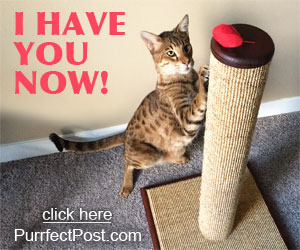Interactive Playing with Wand Toys
Wand toys have unique features that can increase the fun and exercise value of interactive play sessions with your cat.
 Wand-ering Faux-Critters Bring Genuine Excitement to Kitty’s Playtime
Wand-ering Faux-Critters Bring Genuine Excitement to Kitty’s Playtime
With wand toys, you can make the “prey” crawl, climb, or fly through the air, to your kitty’s delight—and the manipulator of the prey’s action (you) is far enough away so that the prey’s movements seem autonomous. In fact, since the toy bug, bird, or burrower is attached to a string and is usually light enough to be affected by air currents and tiny obstructions on the ground, there is a degree of randomness to its actions.
Although our cats are too smart to mistake a toy moth or mouse for the real thing, the life-like actions of the toy prey, which you indirectly control through the wand, stimulate their hunting instincts and inspire them to put on their thinking caps. Fake prey generates real play!
Another advantage to wand toys is that since you’re at one end of the toy and your feline counterpart is at the other end, she can claw and bite with abandon, with no danger to your hands.
General Tips for Getting the Most Out of Wand Toys
Here are some things to keep in mind when using wand toys during your cat's play time:
- Unless your kitty has endless fascination with and preference for a specific toy, rotate toys; this keeps play times more fresh and surprising.
- Small, subtle movements by the “prey”—even the slight flutter of a wing—may be more compelling to a kitty than giant arcs and swoops.
- Give your kitty time to analyze. If the toy (“toy” refers to the prey part of the toy from here on) lands on the couch and your kitty is staring at it intently, she may be planning a surprise attack. Leave the toy in place long enough for your kitty to execute her move. A start-and-stop pattern for the toy typically elicits more kitty involvement than constant movement does.
- Some coyness on the part of the toy usually heightens interest. For example, have the toy hide in a box or bag with just a bit of an occasionally quivering tail sticking out.
- As the play session ends—preferably with a decisive victory pounce—let the toy lose steam and “die.” Then you can carry off the defeated prey until it springs back to life and reappears in a week or so.
- Keep wand toys hidden and inaccessible to your cat when not in use. In addition to making the toys seem fresher when they are reintroduced into play sessions, feathers and small objects attached to wand toys may have sharp or extractable parts that are dangerous for cats unless used under supervision.
Mix it Up with Props for Your Cat
Incorporating furniture, paper bags, boxes, and other items around the house into the play arena—as long as they’re safe—adds new dimensions to the wand toy play experience. Here are a few ideas—but you can go way beyond this; be as imaginative as you want to be:
- Drape a blanket or large towel over a big chair, tucking it in or weighing it down so it stays in place. This serves as a great hiding spot for the critter at the end of the wand toy—unless the kitty claims the hiding place first. Either way, the prey can dart behind the blanket (from kitty’s point of view)—and possibly come out on the other side. Shenanigans are sure to ensue.
- Set up a paper bag for your kitty to explore (remove handles). While she’s in there, being stealthy, have the toy graze the bag, perhaps traveling down its length or traversing the top of the bag. Your kitty will bat at the creature that’s just outside her hideaway. Slowly drag the toy to the bag’s opening—and watch the lightening paw grab it!
- Have the toy “escape” into a paper towel tube. Few cats can resist such temptation.
- Cut holes of various sizes in a short cardboard box. The holes should be large enough for a paw to fit through, but not much larger. The elusive prey can use the box as a temporary shelter. As it glides past the portholes, the curious kitty nearby may stick a paw through the window, or plan an ambush for when the prey emerges. This should only be used when you can supervise; put the box away when you aren't around to avoid the dangerous situation of a paw or neck being caught in a hole.
- Larger cardboard boxes make excellent cat hideouts. Add a couple of windows for extra functionality. Then let the fun begin. Make the toy scamper on top of the box, rappel up the box’s side (near a window, so a thrusting paw can grab it), or race it around the box—only so it can land conveniently just below or next to a window.
The possibilities for using props and wand toy manipulations to create play time scenarios in which you are the director and your kitty is the star are unlimited.
Bonus tip: Supercharge the game by dipping the “dangling creature” part of the toy in catnip, or spritzing it with honeysuckle spray.
What About Cats That Are Reluctant to Play?
There are several reasons why a cat may not appear eager to play, or doesn’t seem to be a natural at playing:
- She’s shy
- She’s distrustful of humans
- She was separated from her mother and/or siblings too early and didn’t complete the normal “kitty training course”
Wand toys can be very helpful in these situations because you can be at a distance from the kitty and still gently encourage playing, which can increase confidence and contentment. With a cat that is skittish or perhaps is feeling vulnerable and remaining in hiding, give her plenty of space. Every now and then, have the toy slowly creep along the floor; it should be within swatting distance to the cat but no closer.
Be patient, and respect the cat’s need for privacy. Proceed at a cautious pace, and before you know it, your timid tabby may be transformed into a playful pouncer.
You May Also Like These Articles:
Big Cats Love Boxes Too! VIDEO
How to Play With Your Cat- Part One
How to Play With Your Cat- Part Two





